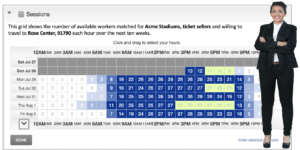 A mature regional hourly labor platform fosters a growing, motivated, workforce aligned with needs. Hiring can be incremental. Metrics identify opportunities.
A mature regional hourly labor platform fosters a growing, motivated, workforce aligned with needs. Hiring can be incremental. Metrics identify opportunities.
Extra labor on tap
 A platform makes it easy to trial an idea for a business. Assume a temporary receptionist aspiring to be a wedding celebrant. He can use it to offer his celebrant credentials seamlessly, exploiting his track record generated as a diligent front desk attendant.
A platform makes it easy to trial an idea for a business. Assume a temporary receptionist aspiring to be a wedding celebrant. He can use it to offer his celebrant credentials seamlessly, exploiting his track record generated as a diligent front desk attendant.
As his wedding bookings mount, he may ramp up his rates and turn off lower paying receptionist clients. If his way of conducting ceremonies proves popular, he can go into the system as a buyer of labor to seek local individuals with customer-facing skills and demonstrable reliability. A short list of two or three can be booked as his assistant for upcoming ceremonies. That’s how he gets to know them. At any point he can set up a business, train his own celebrants, become their intermediary and – perhaps – allow them to be booked through GoodFlexi.
For a later-stage small business not focused on expansion, GoodFlexi offers efficiencies that can level the playing field with corporate competitors. A café owner for example may face a national burger chain opposite her premises. With automated processes, and dozens of outlets locally, the chain can schedule its staff hour-by-hour as footfall fluctuates.
A local labor platform allows her to easily induct, perhaps, 10 locals with catering experience, monitor their collective availability and book them as needed. Each can, of course, be doing all sorts of other work as well. Small businesses boost growth, creating jobs. Helping them match the might of aggressive corporates keeps them sustainable.
An aligned workforce
A successfully launched platform should develop not just an easily booked workforce but one that responds to evolving business needs in their area. The eco-system of intermediaries and public agencies, all able to access granular day-to-day data, should create new potential for:
- Skills: A stream of earning opportunities require basic computer skills, reliability and ability to discuss instructions. Those with high re-booking rates clearly have a solidity about their work that merits investment in more formal training. The platform will show a manager which skills are available, hour-by-hour around her, for example, call center and link her to local workers who are readiest for upskilling according to her parameters.
- Hiring: “Try before you buy” can de-risk recruitment. Instead of relying on formal qualifications and interview skills, platform workers flagging themselves as seeking full-time can be prioritized in bookings to, for example, sort packages. The ones that work well can then be tagged for escalating hours until both sides are happy to create a formal job.
- Leavers: Ceasing employment can also be less of a cliff. An employee approaching retirement age can be offered the chance to sell her hours back to the firm at times of her choosing, perhaps with some guaranteed hours as incentive.
- Staffing-led opportunities: You own a specialist candy manufacturing plant. Running the production line requires people who blend ingredients, ensure quality, work the packing machine and dispatch the goods. You have a template on the local GoodFlexi for numbers of people required against each role and an alert set for anytime outside normal hours when everyone on the list is available. Suddenly you are informed the mix of people you need is showing availability for Sunday. The total cost is displayed. A quick calculation of extra sales might have you clicking “Activate”.
Reduced overheads
 Staffing is the biggest budget item by far for most service businesses. Our platform is committed to raising pay through worker advancement, it will price in tax and enforce all regulations. But it will seriously attack other overheads for a business needing, say, promotions staff next Tuesday morning and Friday evening.
Staffing is the biggest budget item by far for most service businesses. Our platform is committed to raising pay through worker advancement, it will price in tax and enforce all regulations. But it will seriously attack other overheads for a business needing, say, promotions staff next Tuesday morning and Friday evening.
Without GoodFlexi, the full outlay for that staffing requirement will include:
- Time: A manager will often have to phone or message agencies/individuals in search of available workers. She may go to several websites. Then she waits for responses. It’s a long way from the reliable one-click booking taken for granted elsewhere in the economy.
- Uncertainty: Some sites purport to offer instant booking of workers. Their algorithms assign the requirement to a person but, in reality, those people may just not turn up. As these marketplaces come and go there’s little comeback from being downgraded for non-appearance. If a worker changes their mind, they just move on to other markets.
- Quality: The rate at which workers become disillusioned with commoditizing online exchanges and agencies suggests low responsibility or commitment to progression through their market. There’s a good chance the manager will get an uncaring, possibly truculent, team to work with.
- Administration charges: A staffing agency might offer to find workers for a fragmented requirement. But it’s going to involve phoning/texting/messaging by someone in the office; those costs have to be recouped.
 Risk: Word of mouth, off-the-books, bookings from a group of known workers do get detected. Employers go to court. But risk of detection is part of the overheads of arranging contingent labor that many smaller businesses currently live with to avoid high charges from agencies and apps. A better market can diminish the appeal of informal bookings.
Risk: Word of mouth, off-the-books, bookings from a group of known workers do get detected. Employers go to court. But risk of detection is part of the overheads of arranging contingent labor that many smaller businesses currently live with to avoid high charges from agencies and apps. A better market can diminish the appeal of informal bookings.
GoodFlexi competes on convenience, reliability, motivation, process costs, and legitimacy. It takes 20 seconds to book 10 promotions workers for the exact hours required. Each is working at times of their choosing, and may not be leafleting for long. But they are building a portfolio track record with roads into better work so they have every reason to do a good job.
A more stable economy
Much flexible labor is currently engaged via the shadow, off-the-books economy. That’s unfair competition for legitimate businesses. Our platform can match the convenience of apps without their high charges, which should reduce that activity.
Other stabilizing impacts could then include:
 Rising average earnings: These grow partly as a result of increased options, and reduced switching costs, for workers. Secondary employment for usefully qualified, but lower paid, individuals is likely to also feature; teachers and nurses moonlighting as babysitters for instance. So, there’s more to spend with local businesses.
Rising average earnings: These grow partly as a result of increased options, and reduced switching costs, for workers. Secondary employment for usefully qualified, but lower paid, individuals is likely to also feature; teachers and nurses moonlighting as babysitters for instance. So, there’s more to spend with local businesses.- Inward investment: GoodFlexi can offer incoming or start-up enterprises a turn-key workforce. If a printing business is seeking somewhere to open a new plant, GoodFlexi can immediately show the required skills, their utilization, location and pay rates. This is not bland survey findings, it’s real-time data from today’s market. The printer can see how quickly they could get presses rolling and cost each step of their market entry.
- Resilience: Our system fosters workers with broad skills and self-reliance. In case of emergency, it can be used to assemble specific skills possibly unpaid, each with a known set of tolerances and experience. (“We need 100 volunteers to watch for wildfires. Please accept the role description and make yourself available this afternoon.”) If radical projects like guaranteed minimum income are called for, or if available work is to be spread around as many people as possible, GoodFlexi is an ideal platform for immediate, secure, auditable, cost-effective, administration.
- Public services: Town planning, classroom teaching, and traffic design all fit the model of regular work in a regular place; done entirely by people in jobs. But social work, legal casework, building repairs, environmental clean ups, and other less predictable services may benefit from a pool of qualified top-up workers booked on their own terms as demand fluctuates. Again, this is spreading skills through the local workforce rather than keeping them in City Hall.
Metrics to watch
 GoodFlexi’s hose of data contains some benchmarks anyone with an eye on local business health will want to watch:
GoodFlexi’s hose of data contains some benchmarks anyone with an eye on local business health will want to watch:
- Participation rate: GoodFlexi brings people in from the labor market fringes. Growing participation for people outside regular hours of availability indicates a waning shadow economy and supported workers.
- System leavers: If a worker stops listing availability the system could ask why, using a simple dropdown of options. The count of “Now self-employed” responses will be an indicator of overall small business launches.
- Recurring bookings and length of bookings: Rising regularity in bookings of flexible labor – companies going from average 5 hours booking length to average 10 hours for example, or committing to bookings for weeks ahead – could be a first signs of an uptick in business confidence.
- Workers hiring other workers: Again, it’s an early sign of businesses starting.
- Inductions: If businesses are using the platform to organize induction sessions for potential workers it’s a sign they expect to be using more labor soon, even if that hasn’t started yet.
 Any local implementation of GoodFlexi will also feed into general economic monitoring, tracking hours booked in key labor market sectors such as building, hospitality, or care. But its more specific metrics, like those above, will probably shape a mayor or governor’s thinking on how to target training initiatives or support for key sectors.
Any local implementation of GoodFlexi will also feed into general economic monitoring, tracking hours booked in key labor market sectors such as building, hospitality, or care. But its more specific metrics, like those above, will probably shape a mayor or governor’s thinking on how to target training initiatives or support for key sectors.
→ About

